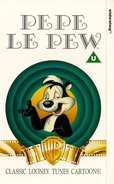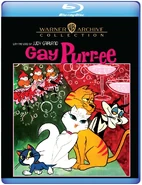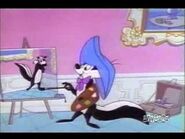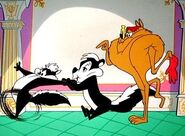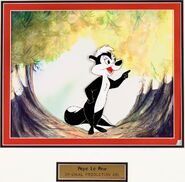Louvre Come Back to Me! is a 1962 Looney Tunes short directed by Chuck Jones and Maurice Noble.
Title[]
The title is a play on the song "Lover, Come Back to Me". It also references the Louvre, where the cartoon takes place.
Plot[]
In Paris, Pepé Le Pew is strolling and causing a disturbance with his fumes; flowers wilt, birds fall out of a tree and become stuck in the ground by their beaks, among other reactions. At one point, a girl cat called Felice is walking with a ginger cat boyfriend named Pierre and Pepé's stink causes the ginger cat to faint and Felice to spring in the air, her back making contact with a fresh white-painted flagpole before she falls right into Pepé's arms, complete with unknowingly kissing him in the process. As Pepé introduces himself, as usual believing her to be a female skunk, Felice scurries away, with Pepé wondering, "I am playing it too cool, no?"
Pepé chases Felice into the Louvre, with the ginger cat following. Inside, Pepé's stench ruins a couple of sculptures as he hops past them (A statue holding a ball in one hand loses its grip on the ball which falls onto their foot, causing the statue to grip said foot in pain, and then a statue resembling Lady Liberty loses its crown and arms, "correcting" it into the Venus de Milo). As Pepé tries to find Felice, the ginger cat is lying in wait for him around a corner, but his ambush attempt is inadvertently thwarted by Pepé's fumes. Due to the cat turning white from this, Pepé mistakes him for a sculpture, saying to himself "I don't know why but I don't really go for this modern sculpture". As Pepé wanders off, the cat's teeth, whiskers, tail, and nose fall off, after which he flees, but he returns briefly to sweep up the bits of him that dropped off. Pepé finds Felice in the sculpture gallery, indavertantly creating a large heart-shaped hole in one when he tries to surprise her. When Felice finds herself cornered, Pepé decides to paint a picture of her, while telling her "Don't move, darling. I want to remember you just as you are". While he is distracted with this, she scurries away again, and Pepé "accidentally" paints the dust cloud she left onto his picture ("Aw, shucks... You moved!").
Outside, Pierre pumps himself with air via bicycle pump in an attempt to simultaneously look strong and muscular and hold his breath while he confronts Pepé, who is busy kissing Felice on the arm as she tries to run away. When Pierre slaps Pepé with a glove (as if to say "Hey, skunk. Hands off her!"), the skunk plays along with this confrontation as if this "jealous lover" wishes to "risk his life in a duel over this fair one." As Pepé starts to act out this hypothetical duel, Pierre starts to slowly suffocate. Once at the end of his paces, Pepé mimes a miss and "awaits" Pierre's "shot", not noticing the cat is starting to squirm from lack of air. When Pepé then mimes a defeat and fall to the floor, Pierre ends up unable to hold the air he was fighting very hard to keep in anymore and forces it out, launching himself into the Hall d'Armour and trapping himself in a helmet and breastplate display, effectively putting him out of action. Pepé, who was expecting Felice to come back and "grieve" for him, wonders after picking himself up where everyone has gone to. After getting up and starting to walk off, he tells himself, "Oh well, war is fine, but love is better! Right?" At that moment, he immediately picks up on where Felice went.
Pepé finds Felice hiding in the air conditioning machine below the Louvre and traps her in it with himself believing she found a trysting place for them. As he confesses to Felice how he had given up art for her and was willing to settle down and be a travelling salesman, Pepé's fumes spread through the Louvre spoiling various works of art (the limp watches of Salvador Dalí's The Persistence of Memory turn erect and break while the head and insects pass out, the heads of the couple on Grant Wood's American Gothic retreat into their bodies in the manner of turtles, the person overseeing the workers on Jean-François Millet's The Gleaners shoots a starting pistol causing the workers to dash off like sprinters, and the color on Edgar Degas's Two Dancers falls off turning it into a paint-by-numbers picture). The cartoon ends with the fumes causing Leonardo da Vinci's Mona Lisa to talk ("I can tell you chaps one thing. It's not always easy to hold this smile.").
Availability[]
The Looney Tunes Video Show Volume 3
Pepe Le Pew (1990)
Special Bumper Collection (Vol. 4)
Looney Tunes Collection - Pepe le Pew
Classic Bumper Collection
Looney Tunes: The Collectors Edition Volume 14: Cartoon Superstars
Streaming[]
Notes[]
- This is the final theatrically released short to star Pepé Le Pew, Penelope Pussycat, and Claude Cat in the Golden Age of American Animation.
- This is the first appearance of Claude Cat (as Pierre) since the 1958 short "Cat Feud", and his final appearance in theatrical shorts in the Golden Age of American Animation.
- The whole sequence of Pierre's challenge with Pepé is left out when this short was used in the compilation movie Daffy Duck's Movie: Fantastic Island.
- This short plays in PAL audio on Cartoon Network and Boomerang.
- This is one of the seven cartoons (not counting "The Jet Cage", as William Lava also did music for that short) that were released posthumously after Milt Franklyn's death, alongside "Mexican Boarders", "Bill of Hare", "Zoom at the Top", "The Slick Chick", "Honey's Money", and "Mother Was a Rooster".
- While trying to hide from Pepé, Penelope (as Felice) stands in front of an abstract sculpture with the title "Le TULIP". In the bottom right corner of the piece are the initials "C.J.", for Chuck Jones.
Gallery[]
TV Title Cards[]
| Pepé Le Pew Cartoons | ||||
|---|---|---|---|---|
| 1945 | Odor-able Kitty | |||
| 1947 | Scent-imental over You | |||
| 1948 | Odor of the Day | |||
| 1949 | For Scent-imental Reasons | |||
| 1951 | Scent-imental Romeo | |||
| 1952 | Little Beau Pepé | |||
| 1953 | Wild over You | |||
| 1954 | Dog Pounded • The Cats Bah | |||
| 1955 | Past Perfumance • Two Scent's Worth | |||
| 1956 | Heaven Scent | |||
| 1957 | Touché and Go | |||
| 1959 | Really Scent | |||
| 1960 | Who Scent You? | |||
| 1961 | A Scent of the Matterhorn | |||
| 1962 | Louvre Come Back to Me! | |||
| 1995 | Carrotblanca | |||


